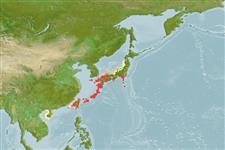Teleostei (teleosts) >
Callionymiformes (Dragonets) >
Callionymidae (Dragonets)
Etymology: Callionymus: Greek, kallion, comparative of kallos = beautiful + Greek, onyma = name; with a better name; ikedai: Named for Yuji Ikeda who reared the male paratype to maturity in an aquarium.
Eponymy: Yuji Ikeda, about whom we are told very little in the etymology. [...] (Ref. 128868), visit book page.
Environment: milieu / climate zone / depth range / distribution range
Ecology
Marine; brackish; demersal; depth range 1 - 8 m (Ref. 27315). Temperate
Northwest Pacific: Iriomote Island, Japan.
Size / Weight / Age
Maturity: Lm ? range ? - ? cm
Max length : 2.3 cm SL male/unsexed; (Ref. 27315)
Found over sandy-muddy bottom (Ref. 27315).
Life cycle and mating behavior
Maturity | Reproduction | Spawning | Eggs | Fecundity | Larvae
Nakabo, T., H. Senou and M. Aizawa, 1998. New species of Pseudocalliurichthys (Teleostei: Callionymidae) from Iriomote Island, Japan. Copeia 1998(2):451-455. (Ref. 27315)
IUCN Red List Status (Ref. 130435: Version 2024-1)
Threat to humans
Harmless
Human uses
Tools
Special reports
Download XML
Internet sources
Estimates based on models
Preferred temperature (Ref.
123201): 20.5 - 26.3, mean 23.3 °C (based on 102 cells).
Phylogenetic diversity index (Ref.
82804): PD
50 = 0.5000 [Uniqueness, from 0.5 = low to 2.0 = high].
Bayesian length-weight: a=0.00891 (0.00410 - 0.01937), b=2.78 (2.60 - 2.96), in cm total length, based on LWR estimates for this Genus-body shape (Ref.
93245).
Trophic level (Ref.
69278): 3.1 ±0.4 se; based on size and trophs of closest relatives
Resilience (Ref.
120179): High, minimum population doubling time less than 15 months (Preliminary K or Fecundity.).
Fishing Vulnerability (Ref.
59153): Low vulnerability (10 of 100).
